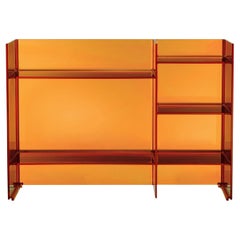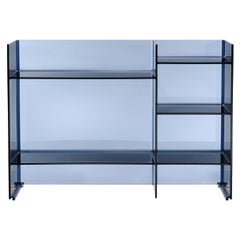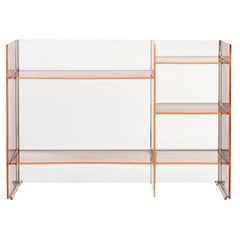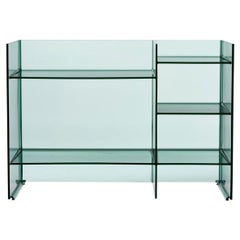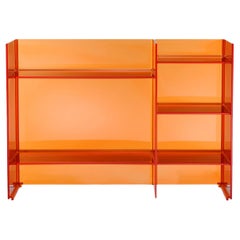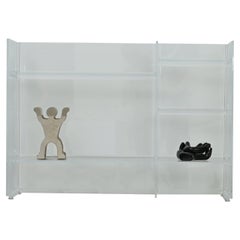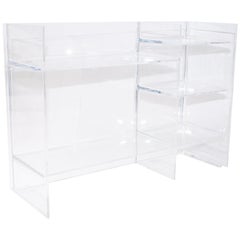Kartell Sound Rack
21st Century and Contemporary Italian Modern Shelves
Resin
21st Century and Contemporary Italian Modern Shelves
Resin
21st Century and Contemporary Italian Modern Shelves
Resin
21st Century and Contemporary Italian Modern Shelves
Resin
21st Century and Contemporary Italian Modern Shelves
Resin
21st Century and Contemporary Italian Modern Shelves
Resin
21st Century and Contemporary Italian Modern Shelves
Resin
Early 20th Century Italian Modern Bookcases
Acrylic
Recent Sales
21st Century and Contemporary Italian Modern Shelves
Resin
People Also Browsed
2010s Dutch Modern Side Tables
Resin
Vintage 1970s Italian Mid-Century Modern Vanities
Fabric, Velvet, Glass, Mirror, Plastic
2010s Italian Modern Console Tables
Concrete
21st Century and Contemporary Italian Modern Ladders
Aluminum
2010s American Mid-Century Modern Wall Lights and Sconces
Brass, Nickel, Enamel, Bronze
2010s South African Minimalist Night Stands
Poplar, Burl
2010s French Other Wall Mirrors
Ceramic
2010s Italian Modern Wall Mirrors
Brass
2010s South African Minimalist Pedestals
Wood
21st Century and Contemporary Brazilian Modern Armchairs
Bouclé
2010s Greek Night Stands
Wood
21st Century and Contemporary Swedish Mid-Century Modern Table Lamps
Textile
2010s American Modern Wall Lights and Sconces
Brass
21st Century and Contemporary Italian Modern Table Lamps
Resin
2010s Oceanic Organic Modern Ottomans and Poufs
Fabric, Foam
2010s American Modern Table Lamps
Brass, Silver Leaf, Steel
Kartell for sale on 1stDibs
The Italian design giant Kartell transformed plastic from the stuff of humble household goods into a staple of luxury design in the 1960s. Founded in Milan by Italian chemical engineer Giulio Castelli (1920–2006) and his wife Anna Ferrieri (1918–2006), Kartell began as an industrial design firm, producing useful items like ski racks for automobiles and laboratory equipment designed to replace breakable glass with sturdy plastic. Even as companies like Olivetti and Vespa were making Italian design popular in the 1950s, typewriters and scooters were relatively costly, and Castelli and Ferrieri wanted to provide Italian consumers with affordable, stylish goods.
They launched a housewares division of Kartell in 1953, making lighting fixtures and kitchen tools and accessories from colorful molded plastic. Consumers in the postwar era were initially skeptical of plastic goods, but their affordability and infinite range of styles and hues eventually won devotees. Tupperware parties in the United States made plastic storage containers ubiquitous in postwar homes, and Kartell’s ingenious designs for juicers, dustpans, and dish racks conquered Europe. Kartell designer Gino Colombini was responsible for many of these early products, and his design for the KS 1146 Bucket won the Compasso d’Oro prize in 1955.
Buoyed by its success in the home goods market, Kartell introduced its Habitat division in 1963. Designers Marco Zanuso and Richard Sapper created the K1340 (later called the K 4999) children’s chair that year, and families enjoyed their bright colors and light weight, which made them easy for kids to pick up and move. In 1965, Joe Colombo (1924–78) created one of Kartell’s few pieces of non-plastic furniture, the 4801 chair, which sits low to the ground and comprised of just three curved pieces of plywood. (In 2012, Kartell reissued the chair in plastic.) Colombo followed up on the success of the 4801 with the iconic 4867 Universal Chair in 1967, which, like Verner Panton’s S chair, is made from a single piece of plastic. The colorful, stackable injection-molded chair was an instant classic. That same year, Kartell introduced Colombo’s KD27 table lamp. Ferrierei’s cylindrical 4966 Componibili storage module debuted in 1969.
Kartell achieved international recognition for its innovative work in 1972, when a landmark exhibition curated by Emilio Ambasz called “Italy: The New Domestic Landscape” opened at New York’s Museum of Modern Art. That show introduced American audiences to the work of designers such as Gaetano Pesce; Ettore Sottsass, founder of the Memphis Group; and the firms Archizoom and Superstudio (both firms were among Italy's Radical design groups) — all of whom were using wit, humor and unorthodox materials to create a bracingly original interior aesthetic.
Castelli and Ferrieri sold Kartell to Claudio Luti, their son-in-law, in 1988, and since then, Luti has expanded the company’s roster of designers.
Kartell produced Ron Arad’s Bookworm wall shelf in 1994, and Philippe Starck’s La Marie chair in 1998. More recently, Kartell has collaborated with the Japanese collective Nendo, Spanish architect Patricia Urquiola and glass designer Tokujin Yoshioka, among many others. Kartell classics can be found in museums around the world, including MoMA, the Victoria and Albert Museum and the Cooper Hewitt, Smithsonian Design Museum. In 1999, Claudio Luti established the Museo Kartell to tell the company’s story, through key objects from its innovative and colorful history.
Find vintage Kartell tables, seating, table lamps and other furniture on 1stDibs.
A Close Look at Modern Furniture
The late 19th and early 20th centuries saw sweeping social change and major scientific advances — both of which contributed to a new aesthetic: modernism. Rejecting the rigidity of Victorian artistic conventions, modernists sought a new means of expression. References to the natural world and ornate classical embellishments gave way to the sleek simplicity of the Machine Age. Architect Philip Johnson characterized the hallmarks of modernism as “machine-like simplicity, smoothness or surface [and] avoidance of ornament.”
Early practitioners of modernist design include the De Stijl (“The Style”) group, founded in the Netherlands in 1917, and the Bauhaus School, founded two years later in Germany.
Followers of both groups produced sleek, spare designs — many of which became icons of daily life in the 20th century. The modernists rejected both natural and historical references and relied primarily on industrial materials such as metal, glass, plywood, and, later, plastics. While Bauhaus principals Marcel Breuer and Ludwig Mies van der Rohe created furniture from mass-produced, chrome-plated steel, American visionaries like Charles and Ray Eames worked in materials as novel as molded plywood and fiberglass. Today, Breuer’s Wassily chair, Mies van der Rohe’s Barcelona chair — crafted with his romantic partner, designer Lilly Reich — and the Eames lounge chair are emblems of progressive design and vintage originals are prized cornerstones of collections.
It’s difficult to overstate the influence that modernism continues to wield over designers and architects — and equally difficult to overstate how revolutionary it was when it first appeared a century ago. But because modernist furniture designs are so simple, they can blend in seamlessly with just about any type of décor. Don’t overlook them.
Finding the Right Bookcases for You
Whether you proudly shelve your books in regal mahogany or behind glass cabinet doors, an antique bookcase — or perhaps more than one — is essential to creating a cozy nook for any book lover.
As long as curious people have collected stories, we have needed a place to stow them away and preserve them. When auction houses and book dealers proliferated by the late 17th century, the bibliophile was born. And, of course, as with any treasured decorative objects or collectibles, a book lover’s volumes were suddenly worthy of a luxurious display — enter the bookcase.
Americans of means during the 19th century took to amassing art as well as rare books, and bookcases of the era — rife with hand-carved decorative accents and architectural motifs — were ideal for displaying their handsome leather-bound wares.
Although our favorite titles may change over the years, the functionality and beauty of their home within our home is timeless. Even those who don’t covet the perfect home library can benefit from an attractive display case, as bookcases can easily double as charming étagères.
Contemporary and customizable options make it easier for you to find the perfect bookcase for your style and stacks. If you don’t wish to fill your storage piece so that your collection is snug within its confines, incorporate extra space to allow for additional displays and decorative objects. And by introducing a striking dark wood Art Deco bookcase or low-profile mid-century modern design by Paul McCobb into your living room, your signed first editions won’t be the only items making a statement.
Find barrister bookcases, Globe Wernicke bookcases, bookcases with doors and other vintage and antique bookcases on 1stDibs now.
- How do you tell a real Kartell?1 Answer1stDibs ExpertOctober 15, 2024To tell a real Kartell, look for the maker's markings. Nearly all authentic pieces will feature an embossed mark that indicates the Kartell name, the product name and the designer name. If your piece lacks any of these three marks or the marking is printed in ink on the piece or on a paper label, it may be a replica. You can also research identifying characteristics for your particular type of furniture and use these to evaluate your item. Alternatively, you can seek the opinion of a certified appraiser or knowledgeable dealer. Find a variety of Kartell furniture on 1stDibs.
- Is Kartell an Italian brand?1 Answer1stDibs ExpertSeptember 9, 2024Yes, Kartell is an Italian brand. Giulio Castelli and his wife, Anna Ferrieri, founded the company in Milan in 1949. Originally, Kartell was an industrial design firm, producing items like ski racks for automobiles and laboratory equipment to replace breakable glass with sturdy plastic. It first introduced its housewares division in 1953. Find a large selection of Kartell furniture on 1stDibs.
